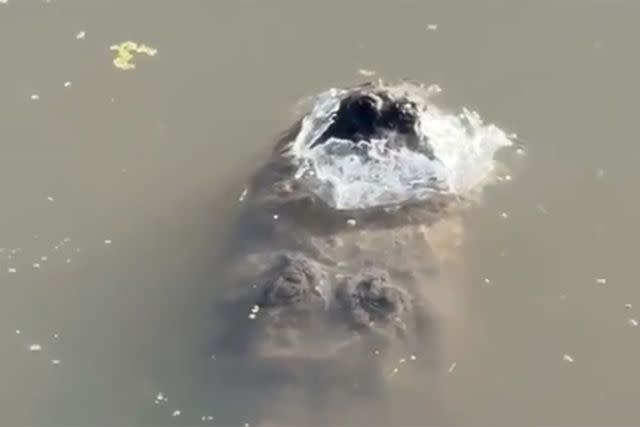Alligators in Texas, North Carolina Still Alive in Iced-Over Ponds Thanks to Their 'Danger Snorkel' Technique

"We bundle up, but this is what the American alligator does," a park employee said of the creatures' winter habit
In the wintertime, “see you later, alligator” takes on a whole new meaning!
Following a particularly frigid bout of weather, an alligator at Gator Country in Beaumont, Texas, was found with nearly its entire body frozen in water — but it was still breathing.
Gary Saurage, the alligator park’s owner, shared a video of the submerged alligator on TikTok, giving viewers a glimpse into the rare sight.
"You guys want to see something really cool? We all know what alligators do during the summer and spring,” Saurage says in the clip. “But what do they do in the winter and how do they survive?"
Related: Mich. Officer Enlists Dog to Help Rescue Owner, Who Fell Into Frozen Lake
The camera then pans to the gator, who is floating below the iced-over water with just its nostrils poking through a small hole in the ice.
In a viral video of the same alligator, shared by Gator Country employee Eddie Hanhart says, “We bundle up, but this is what the American alligator does.”
“See he knew he was gonna freeze last night, so what he does is he went and found him a nice comfy spot, stuck his nose out the water and let the ice freeze around his nose,” Hanharrt says in the video, which amassed over 6 million views.
Hanhart adds that when the layer of ice thaws, the gator will “get up on the bank” and “start soaking in all those nice hot sun rays” to warm up.
Never miss a story — sign up for PEOPLE's free daily newsletter to stay up-to-date on the best of what PEOPLE has to offer, from celebrity news to compelling human interest stories.
According to both Saurage and Hanhart, the iced-over reptile is in a hibernation-like state.
"That animal is in full hibernation right there,” says Saurage, claiming that the alligator’s heart was beating around three beats per minute.
“Folks, that’s amazing,” he adds. “That’s how alligators survive in the ice.”

Related: Indiana Firefighters Rescue Dog from Icy River: See the Photos
But alligators don’t hibernate, at least not technically. They brumate.
Brumation is the reptilian equivalent of mammal hibernation, according to Encyclopædia Britannica.
The main difference between the two? Level of inactivity.
While hibernation consists of long, sustained periods of inactivity without food or drink, reptiles who are brumating stir occasionally to drink water, per Encyclopædia Britannica.
According to the Texas Parks & Wildlife Department, alligators in the state brumate from mid-October to early March, and the months following brumation (from about March 1 through May 30) are peak time for breeding and nesting.
Related: Rescued Alligator with Top Half of Jaw Missing Finds New Home at Florida Park
A few other brumating alligators — this time in North Carolina — also made headlines by keeping their heads below water this month.
A Facebook video shared by The Swamp Park, an outdoor amusement park in Ocean Isle Beach, North Carolina, shows more “gatorcicles” floating beneath an icy layer of water.
In the clip, a park employee says that when it gets cold enough for the parks' ponds to freeze over, the creatures “instinctively tilt their nose up, to the point to where it’s out of the water, so they don’t just suffocate under the water.”
“Think of it as a cute little danger snorkel,” the employee adds.
For more People news, make sure to sign up for our newsletter!
Read the original article on People.

